The Himalaya's hidden 'paradise valleys'
(Image credit: Stuart Butler)
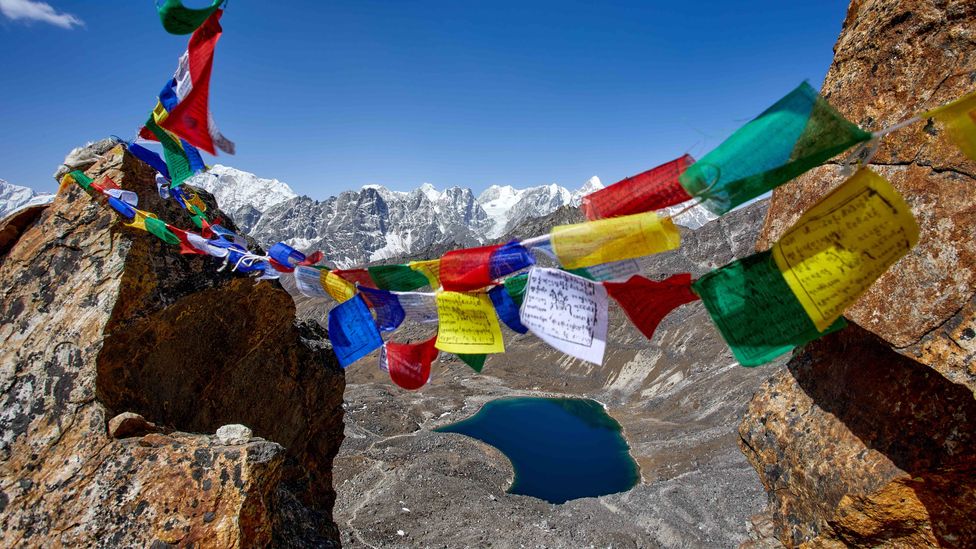
By Stuart Butler
31st August 2022
According to Tibetan Buddhists, their location will only be revealed at very specific moments in time when the world is under enormous stress and in danger of destruction.
Looking out of the monastery doorway at columns of rock and spires of ice soaring 7,000m into the heavens, the Buddhist monk smiled and said, "I am home. In my paradise." He then turned his attention back to the classroom where he was teaching young novice monks. I thanked him, shut the door behind me and walked away from the monastery. Away from the small village of Thame with its sturdy stone houses and fields of barley and potatoes. Away from the huge Himalayan peaks. And away from the beyul.
Story continues below
A beyul is a sacred place and sanctuary to which lamas could lead people in times of strife and trouble
An integral belief in the Nyingma school of Tibetan Buddhism, established in the 8th Century and the oldest of the four different schools, a beyul is a place where the physical and spiritual worlds overlap. Specifically, they are hidden paradise valleys whose location will only be revealed at very specific moments in time when the world is under enormous stress and in danger of destruction through war, famine or plague. At such times, it's believed, a beyul becomes a refuge in an unstable world where everything lives in harmony.
"A beyul is a sacred place and sanctuary to which lamas (teachers of Tibetan Buddhism) could lead people in times of strife and trouble," explained Frances Klatzel, author of several books on Himalayan and Buddhist culture, including Gaiety of Spirit – the Sherpas of Everest.
But a beyul cannot be entered by just anyone, she added. Only a true Buddhist with a pure heart who has overcome enormous trial and hardship can enter a beyul. For Nyingma Buddhists, trying to enter a beyul when all the above conditions are not met is likely to lead to death.
As the author of a number of guidebooks to the region and a regular visitor to the Himalaya and Tibetan regions, I found it fascinating that somewhere among the folds of the Himalaya might be hidden lands revealed to a worthy few in times of calamity. Before heading up into the mountains to find out more, however, I asked Klatzel for some background on how the beyuls came to be.
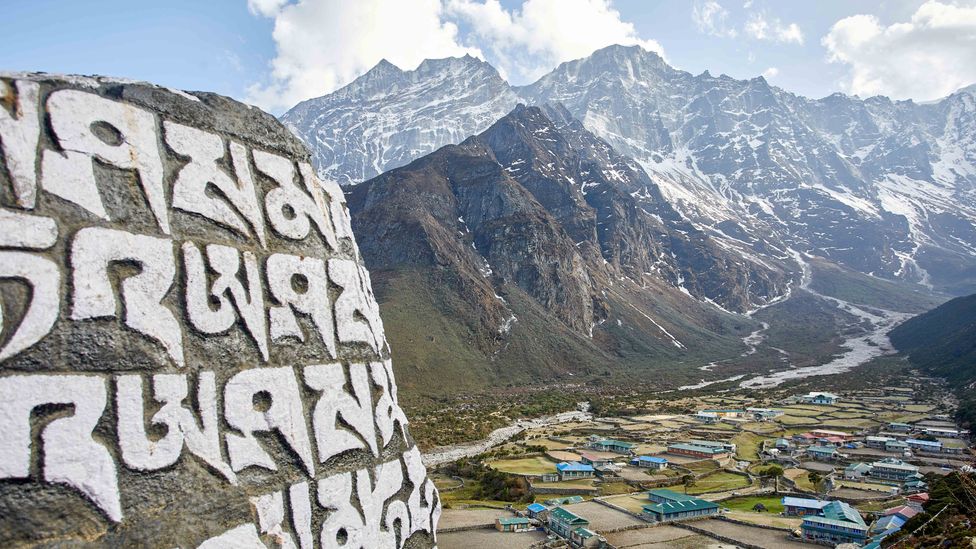
There are believed to be 108 beyuls – though most are yet to be revealed (Credit: Stuart Butler)
She explained that the beyuls were created by Padmasambhava (Guru Rinpoche, or The Lotus Born One), a tantric Buddhist Vajra master who was thought to be instrumental in spreading Buddhism throughout Tibet and the Himalaya around the 8th or 9th Centuries.
"During his travels in the Himalaya, Padmasambhava realised that times of strife would come, so he used his spiritual powers to purify and 'hide' certain valleys and wrote texts describing their locations and the conditions for entering them," she said. These texts were hidden in caves, inside monasteries and behind waterfalls throughout the Himalaya and could only be discovered by lamas at times that were predetermined by Padmasambhava.
Nobody knows exactly how many beyuls there are, but 108 is the most widely accepted figure – though most are yet to be revealed. Most of the areas that have been located are on the south side of the Himalaya, which is greener, wetter and more fertile – more "paradisical" – than the often sterile and harsh Tibetan plateau.
Some of these beyuls – such as in Sikkim in north-east India and the Helambu, Rolwaling and Tsum valleys in Nepal – have been known about by Buddhist practitioners for centuries and are now dotted with villages and towns. Then there are those where the location is known but is inaccessible to most. This is because a beyul can be both a physical place and a spiritual place. It's said that a person could even be stood in a beyul but not be inside it.
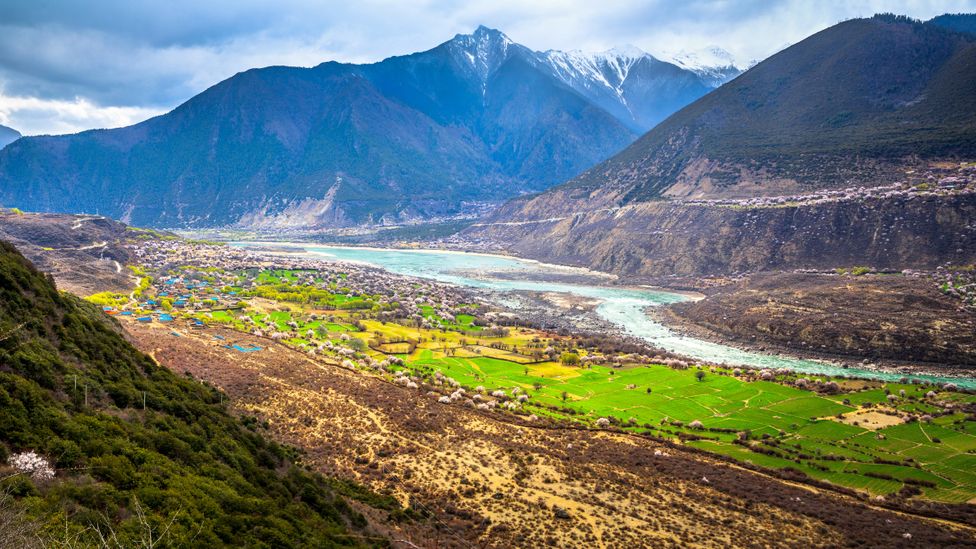
The gateway to Beyul Pemako was said to be hidden on cliffs behind a waterfall in the Yarlung Tsangpo Canyon (Credit: Feng Wei Photography/Getty Images)
It might be easy to consider the idea of a hidden land as something out of a fairy tale, but ancient scrolls giving the details of beyul have indeed been found. Take for example, Beyul Pemako. Located in what is today the remote north-east Indian state of Arunachal Pradesh, the gateway to the revered beyul was noted to be hidden on cliffs behind a waterfall in the most inaccessible part of the Yarlung Tsangpo Canyon, the deepest canyon on the planet, which remained a blank spot on maps until very recently. Nobody even knew if a waterfall existed there. But in the early 1990s, a team of Buddhist practitioners, led by Buddhist scholar Ian Baker – who later wrote about the experience in his book The Heart of the World – finally penetrated the area, where they did indeed discover a high waterfall hidden inside the canyon.
Just as the beyuls themselves seem to be more than legend, so are the stories of a grisly end if you try to enter one when the time isn't right or if you heart is not as pure as you think. In 1962, a respected Tibetan lama named Tulshuk Lingpa claimed to have found a map that would lead to the Beyul Demoshong, the gateway of which was rumoured to be somewhere on the slopes of Mount Kanchenjunga, the world's third highest mountain.
He travelled to the mountain with around 300 followers. As recounted in the book A Step Away from Paradise by Thomas K Shor, survivors of the event recounted that Lingpa and a few others who'd gone on ahead to do a reconnaissance of the route saw a series of bright lights calling them toward a gateway. But rather than entering the beyul, Lingpa returned to gather up all his followers. Unfortunately, instead of crossing a magical threshold into a paradise valley, most of the group – including the lama – were killed by an avalanche.
Others have had more successful attempts to enter a beyul. The Sherpa people are one of those. Today, these renowned climbers, porters and trekking guides are intimately associated with the Nepalese Himalaya, and Mount Everest in particular. But they haven't always lived in the southern shadow of Everest. For most of their history they lived in the Kham region of eastern Tibet (today a part of China's Sichuan province) but, back in the 15th Century, widespread turmoil and conflict in Tibet turned the Sherpa world upside down.
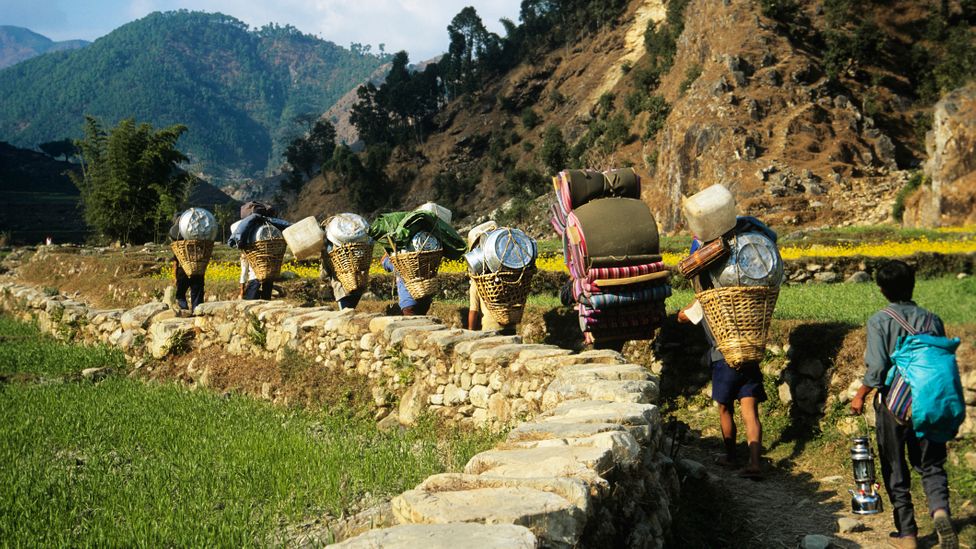
The Sherpa people came to the Khumbu Beyul in the 15th Century after fleeing conflict in Tibet (Credit: Image Source/Getty Images)
==
It was then that Lama Sangya Dorje, a Master Tibetan Buddhist, decided that the time was right to "unlock" the Khumbu Beyul. He led the Sherpas over the daunting Nangpa La pass (5,716m) and into a well-watered land where they could grow crops and graze their yaks in peace. The Sherpas had arrived in the Khumbu (the name given to the area surrounding the Nepalese side of Mount Everest) and, compared to where they'd just come, from it was a vision of a high-altitude paradise.
Nowadays, the Khumbu region welcomes thousands of international visitors each year who come to hike to the famed Everest Basecamp, but few people I met when I visited seem interested or aware that they were in a beyul.
However, there are some corners of the Khumbu region where the spirit of the beyul remains strong. Perched on a steep, forested slope, the Lawudo Gompa is considered one of the most sacred spots in Nepal's Bhote Koshi Nadi valley, located two valleys west of Everest Base Camp.
"Most people think there are just four valleys in the Khumbu region. But that's not true," said Dawa Sangye Sherpa, an 82-year-old nun who has been living at the gompa (a small Tibetan monastery) for more than 50 years. She'd brought me tea and biscuits almost the moment I'd arrived and had readily agreed to tell me more about Lawudo's connection with the Khumbu Beyul.
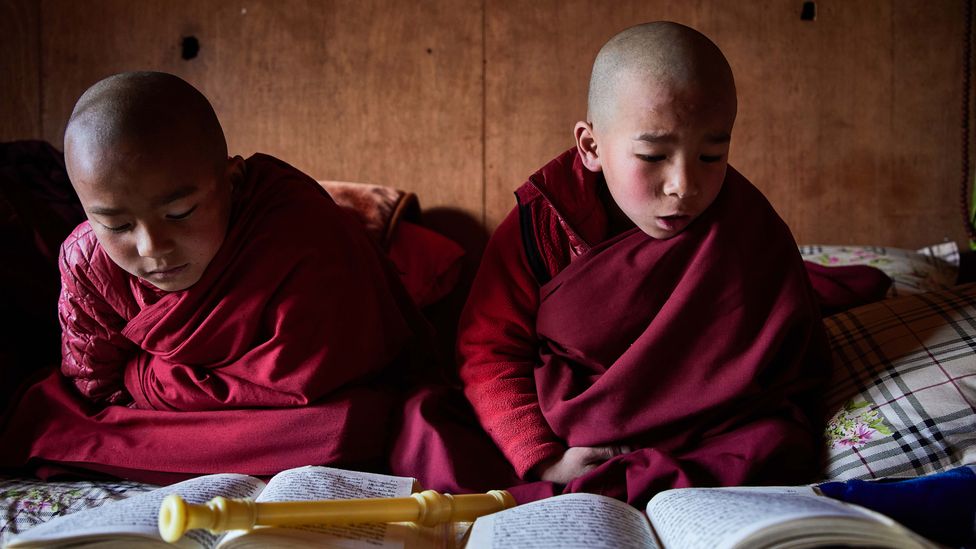
Thame monastery is considered one of the oldest monasteries in the Khumbu and a place of great spiritual significance (Credit: Stuart Butler)
"Behind the gompa is a large cliff called Dragkarma and in the cliff is a gateway that leads to a secret fifth valley," she told me. "That's the heart of the beyul."
This is where Padmasambhava meditated and where he blessed the Khumbu and turned it into a beyul
When I asked if I could see the cliff, Dawa Sangye smiled and shook her head. "But let me show you something else," she said. Leading me behind the main prayer hall, the nun flung open a small door to reveal a room built into and under a rock overhang. Inside, the rock ceiling had been painted the blue of a summer sky and at the far end of the room was a small shrine with a statue of Padmasambhava. At his feet, were offerings left by visitors: a small box of Royal Britannia digestive biscuits, a packet of noodles and some dried flowers.
"This is where Padmasambhava meditated and where he blessed the Khumbu and turned it into a beyul," Dawa Sangye said. Even though I'm not a Buddhist, I found myself running my hand over the cave walls with a sense of wonder flowing over me.
Perhaps seeing my smile, the nun suggested that I go to the village of Thame further up the valley. Situated just at the point where farmland turns to highland yak pastures, Thame monastery, she told me, is considered one of the oldest monasteries in the Khumbu and a place of great spiritual significance. Some even say that it's the spiritual heart of the Khumbu Beyul.
The walking trail from Lawudo to Thame spiralled down cliff faces and crept along a canyon formed by mighty mountain peaks. Then, quite suddenly, the land peeled back to reveal a wide-open valley with the village of Thame at the far end. Pushing open the doors to the main prayer hall of the Thame monastery, I found three elderly monks chanting words written onto yellow-tinged parchments. Breaking off from his recitals, one of them waved for me to sit on the bench next to him.
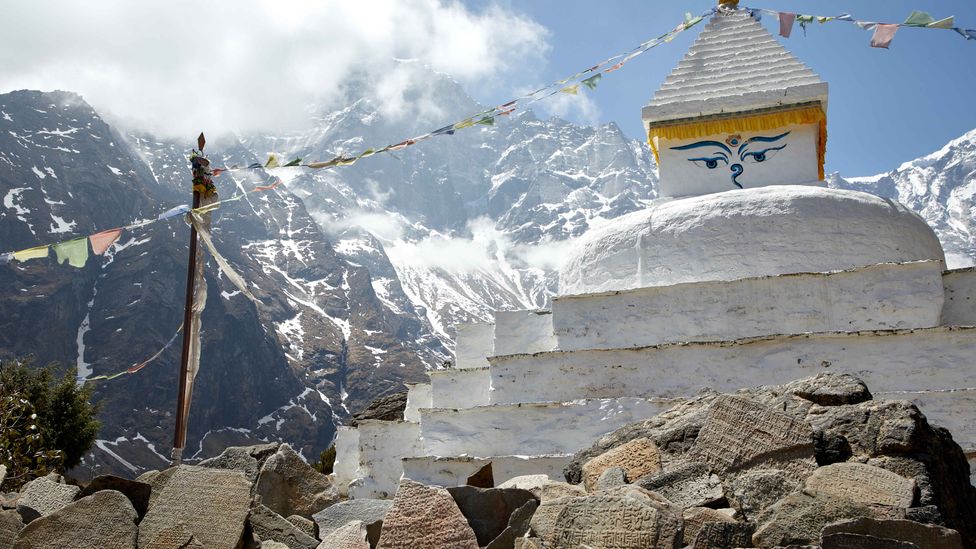
Only a true Buddhist with a pure heart who has overcome enormous trial and hardship can enter a beyul (Credit: Stuart Butler)
"Sometimes, when we are reciting our prayers here, Padmasambhava appears to us," he told me in a hushed tone, adding that Padmasambhava's spirit would tell them that the work they were doing – and the prayers they were offering – were bringing good to the world.
A short time later, I passed the classroom doorway where the Buddhist monk had said, "I am home. In my paradise." Whether or not there were hidden valleys in the Himalaya, it seemed clear that these monks had found their place of peace.
As I left, I was reminded of something that Klatzel had told me before I'd set out: "A beyul is more than just a place, it is a state of mind," she'd said. "Beyul are reminders to prepare ourselves for challenges ahead by developing a calm and steady state of mind that becomes our inner beyul, our inner sanctuary."
--
히말라야의 '숨겨진 낙원'According to Tibetan Buddhists, their location will only be revealed at very specific moments in time when the world is under enormous stress and in danger of destruction.
Looking out of the monastery doorway at columns of rock and spires of ice soaring 7,000m into the heavens, the Buddhist monk smiled and said, "I am home. In my paradise." He then turned his attention back to the classroom where he was teaching young novice monks. I thanked him, shut the door behind me and walked away from the monastery. Away from the small village of Thame with its sturdy stone houses and fields of barley and potatoes. Away from the huge Himalayan peaks. And away from the beyul.
Story continues below
A beyul is a sacred place and sanctuary to which lamas could lead people in times of strife and trouble
An integral belief in the Nyingma school of Tibetan Buddhism, established in the 8th Century and the oldest of the four different schools, a beyul is a place where the physical and spiritual worlds overlap. Specifically, they are hidden paradise valleys whose location will only be revealed at very specific moments in time when the world is under enormous stress and in danger of destruction through war, famine or plague. At such times, it's believed, a beyul becomes a refuge in an unstable world where everything lives in harmony.
"A beyul is a sacred place and sanctuary to which lamas (teachers of Tibetan Buddhism) could lead people in times of strife and trouble," explained Frances Klatzel, author of several books on Himalayan and Buddhist culture, including Gaiety of Spirit – the Sherpas of Everest.
But a beyul cannot be entered by just anyone, she added. Only a true Buddhist with a pure heart who has overcome enormous trial and hardship can enter a beyul. For Nyingma Buddhists, trying to enter a beyul when all the above conditions are not met is likely to lead to death.
As the author of a number of guidebooks to the region and a regular visitor to the Himalaya and Tibetan regions, I found it fascinating that somewhere among the folds of the Himalaya might be hidden lands revealed to a worthy few in times of calamity. Before heading up into the mountains to find out more, however, I asked Klatzel for some background on how the beyuls came to be.

There are believed to be 108 beyuls – though most are yet to be revealed (Credit: Stuart Butler)
She explained that the beyuls were created by Padmasambhava (Guru Rinpoche, or The Lotus Born One), a tantric Buddhist Vajra master who was thought to be instrumental in spreading Buddhism throughout Tibet and the Himalaya around the 8th or 9th Centuries.
"During his travels in the Himalaya, Padmasambhava realised that times of strife would come, so he used his spiritual powers to purify and 'hide' certain valleys and wrote texts describing their locations and the conditions for entering them," she said. These texts were hidden in caves, inside monasteries and behind waterfalls throughout the Himalaya and could only be discovered by lamas at times that were predetermined by Padmasambhava.
Nobody knows exactly how many beyuls there are, but 108 is the most widely accepted figure – though most are yet to be revealed. Most of the areas that have been located are on the south side of the Himalaya, which is greener, wetter and more fertile – more "paradisical" – than the often sterile and harsh Tibetan plateau.
Some of these beyuls – such as in Sikkim in north-east India and the Helambu, Rolwaling and Tsum valleys in Nepal – have been known about by Buddhist practitioners for centuries and are now dotted with villages and towns. Then there are those where the location is known but is inaccessible to most. This is because a beyul can be both a physical place and a spiritual place. It's said that a person could even be stood in a beyul but not be inside it.

The gateway to Beyul Pemako was said to be hidden on cliffs behind a waterfall in the Yarlung Tsangpo Canyon (Credit: Feng Wei Photography/Getty Images)
It might be easy to consider the idea of a hidden land as something out of a fairy tale, but ancient scrolls giving the details of beyul have indeed been found. Take for example, Beyul Pemako. Located in what is today the remote north-east Indian state of Arunachal Pradesh, the gateway to the revered beyul was noted to be hidden on cliffs behind a waterfall in the most inaccessible part of the Yarlung Tsangpo Canyon, the deepest canyon on the planet, which remained a blank spot on maps until very recently. Nobody even knew if a waterfall existed there. But in the early 1990s, a team of Buddhist practitioners, led by Buddhist scholar Ian Baker – who later wrote about the experience in his book The Heart of the World – finally penetrated the area, where they did indeed discover a high waterfall hidden inside the canyon.
Just as the beyuls themselves seem to be more than legend, so are the stories of a grisly end if you try to enter one when the time isn't right or if you heart is not as pure as you think. In 1962, a respected Tibetan lama named Tulshuk Lingpa claimed to have found a map that would lead to the Beyul Demoshong, the gateway of which was rumoured to be somewhere on the slopes of Mount Kanchenjunga, the world's third highest mountain.
He travelled to the mountain with around 300 followers. As recounted in the book A Step Away from Paradise by Thomas K Shor, survivors of the event recounted that Lingpa and a few others who'd gone on ahead to do a reconnaissance of the route saw a series of bright lights calling them toward a gateway. But rather than entering the beyul, Lingpa returned to gather up all his followers. Unfortunately, instead of crossing a magical threshold into a paradise valley, most of the group – including the lama – were killed by an avalanche.
Others have had more successful attempts to enter a beyul. The Sherpa people are one of those. Today, these renowned climbers, porters and trekking guides are intimately associated with the Nepalese Himalaya, and Mount Everest in particular. But they haven't always lived in the southern shadow of Everest. For most of their history they lived in the Kham region of eastern Tibet (today a part of China's Sichuan province) but, back in the 15th Century, widespread turmoil and conflict in Tibet turned the Sherpa world upside down.

The Sherpa people came to the Khumbu Beyul in the 15th Century after fleeing conflict in Tibet (Credit: Image Source/Getty Images)
==
It was then that Lama Sangya Dorje, a Master Tibetan Buddhist, decided that the time was right to "unlock" the Khumbu Beyul. He led the Sherpas over the daunting Nangpa La pass (5,716m) and into a well-watered land where they could grow crops and graze their yaks in peace. The Sherpas had arrived in the Khumbu (the name given to the area surrounding the Nepalese side of Mount Everest) and, compared to where they'd just come, from it was a vision of a high-altitude paradise.
Nowadays, the Khumbu region welcomes thousands of international visitors each year who come to hike to the famed Everest Basecamp, but few people I met when I visited seem interested or aware that they were in a beyul.
However, there are some corners of the Khumbu region where the spirit of the beyul remains strong. Perched on a steep, forested slope, the Lawudo Gompa is considered one of the most sacred spots in Nepal's Bhote Koshi Nadi valley, located two valleys west of Everest Base Camp.
"Most people think there are just four valleys in the Khumbu region. But that's not true," said Dawa Sangye Sherpa, an 82-year-old nun who has been living at the gompa (a small Tibetan monastery) for more than 50 years. She'd brought me tea and biscuits almost the moment I'd arrived and had readily agreed to tell me more about Lawudo's connection with the Khumbu Beyul.

Thame monastery is considered one of the oldest monasteries in the Khumbu and a place of great spiritual significance (Credit: Stuart Butler)
"Behind the gompa is a large cliff called Dragkarma and in the cliff is a gateway that leads to a secret fifth valley," she told me. "That's the heart of the beyul."
This is where Padmasambhava meditated and where he blessed the Khumbu and turned it into a beyul
When I asked if I could see the cliff, Dawa Sangye smiled and shook her head. "But let me show you something else," she said. Leading me behind the main prayer hall, the nun flung open a small door to reveal a room built into and under a rock overhang. Inside, the rock ceiling had been painted the blue of a summer sky and at the far end of the room was a small shrine with a statue of Padmasambhava. At his feet, were offerings left by visitors: a small box of Royal Britannia digestive biscuits, a packet of noodles and some dried flowers.
"This is where Padmasambhava meditated and where he blessed the Khumbu and turned it into a beyul," Dawa Sangye said. Even though I'm not a Buddhist, I found myself running my hand over the cave walls with a sense of wonder flowing over me.
Perhaps seeing my smile, the nun suggested that I go to the village of Thame further up the valley. Situated just at the point where farmland turns to highland yak pastures, Thame monastery, she told me, is considered one of the oldest monasteries in the Khumbu and a place of great spiritual significance. Some even say that it's the spiritual heart of the Khumbu Beyul.
The walking trail from Lawudo to Thame spiralled down cliff faces and crept along a canyon formed by mighty mountain peaks. Then, quite suddenly, the land peeled back to reveal a wide-open valley with the village of Thame at the far end. Pushing open the doors to the main prayer hall of the Thame monastery, I found three elderly monks chanting words written onto yellow-tinged parchments. Breaking off from his recitals, one of them waved for me to sit on the bench next to him.

Only a true Buddhist with a pure heart who has overcome enormous trial and hardship can enter a beyul (Credit: Stuart Butler)
"Sometimes, when we are reciting our prayers here, Padmasambhava appears to us," he told me in a hushed tone, adding that Padmasambhava's spirit would tell them that the work they were doing – and the prayers they were offering – were bringing good to the world.
A short time later, I passed the classroom doorway where the Buddhist monk had said, "I am home. In my paradise." Whether or not there were hidden valleys in the Himalaya, it seemed clear that these monks had found their place of peace.
As I left, I was reminded of something that Klatzel had told me before I'd set out: "A beyul is more than just a place, it is a state of mind," she'd said. "Beyul are reminders to prepare ourselves for challenges ahead by developing a calm and steady state of mind that becomes our inner beyul, our inner sanctuary."
--
2022년 9월 3일
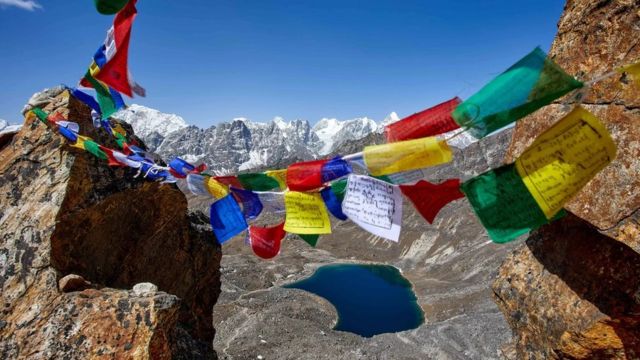
사진 출처,STUART BUTLER
티베트 불교에 따르면, 히말라야에는 낙원이 숨겨져 있다. 이 곳은 전 세계가 엄청난 스트레스를 받거나 파괴될 위험에 처하는 등 매우 긴박한 순간에만 모습을 드러낸다고 한다.
수도원 입구의 바위 기둥과 빙하를 덮은 채 우뚝 솟은 7000m 산을 바라보던 한 승려가 미소를 지으며 말했다. "나는 지금 집에 있습니다. 나의 낙원 안에 있어요." 말을 마친 그는 자신이 젊은 승려들을 가르치는 교실로 시선을 돌렸다. 나는 승려에게 인사를 하고, 수도원을 나왔다. 튼튼한 석조 주택과 보리와 감자가 자라는 밭이 있는 타메의 작은 마을, 거대한 히말라야의 봉우리, 베율에서 멀어진 것이다.
8세기에 설립된 닝마파는 네 개의 티베트 불교 종파 중 가장 오래된 종파다. 여기에선 베율을 물리적 세계와 영적 세계가 겹쳐지는 공간, 숨겨진 낙원이라고 말한다. 이 베율은 세계가 전쟁과 기근, 전염병 등 엄청난 스트레스에 시달리거나 파괴될 위험에 처했을 때만 그 모습을 드러낸다고 한다. 그런 상황 속에서 모든 것이 조화를 이뤄 살아가는 베율이 불안정한 세상의 안식처가 되기 때문이다.
'영적 기쁨-에베레스트의 세르파' 등 히말라야 및 불교 문화에 관해 여러 권의 책을 쓴 프랜시스 클라첼은 "라마(티베트 불교에서 말하는 스승)가 갈등과 고난에 처한 사람들을 이끌어갈 수 있는 신성한 장소이자 성역이 베율"이라고 말했다.
전 세계 최고의 공공 수영장은?
다시 열린 '천국의 섬' 발리...코로나 이전처럼 관광객 찾을까?
하지만 베율은 누구나 들어갈 수 있는 곳은 아니라고 알려져있다. 엄청난 시련과 고난을 극복하고 순수한 마음을 가진 진정한 불교도만 들어갈 수 있다. 닝마파에선 이런 조건을 모두 충족하지 못한 채 베율에 들어가려 하다간 목숨을 잃을 수도 있다고 말한다.
이 지역에 대해 여러 권의 책을 쓰고 주기적으로 히말라야와 티베트를 방문하는 내겐 히말라야 어딘가에 고난 속에서 들어갈 자격을 갖춘 소수에게만 모습을 드러내는 공간이 있다는 이야기가 흥미롭게 다가왔다. 그래서 히말라야로 떠나기 전, 클라첼에게 베율에 대해 좀 더 많은 정보를 물었다.
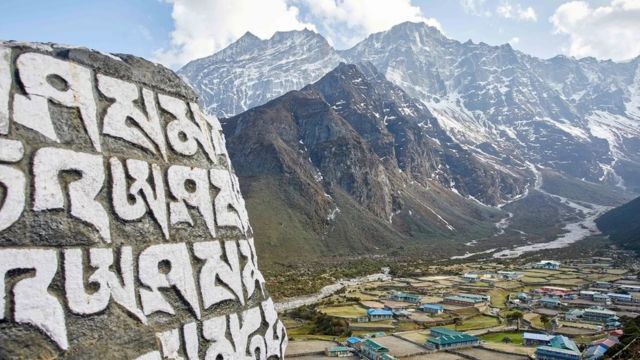
사진 출처,STUART BUTLER
사진 설명,
대부분 아직 드러나지 않았지만, 108곳의 베율이 있다고 한다
그녀는 베율을 만든 사람은 파드마삼바바(그루 린포체, 또는 연꽃에서 태어난 사람)라고 했다. 파드마삼바바는 탄트라(힌두교·불교·자이나교 등에서 행해지는 수행법 또는 수행법을 담은 경전) 지도자다. 탄트라는 8~9세기 티베트와 히말라야에 불교를 전파하는 데 중요한 역할을 했다.
"파드마삼바바가 히말라야를 돌아다니다 갈등의 시기가 올 것을 깨달았어요. 그는 계곡들을 골라 자신의 영적인 힘으로 정화하고 '숨겼어요.' 그리고 그 위치나 그 곳에 들어가기 위한 조건을 글로 남겼죠." 이 글은 동굴과 수도원 내부, 히말라야에 있는 폭포 뒤에 숨겨졌다. 그래서 파드마삼바바가 미리 정해놓은 라마들만 그것을 찾아낼 수 있다고 한다.
배율이 몇 곳인지 정확히 아는 사람은 없다. 다만 108곳이라는 게 정설로 받아들여지고 있다. 물론 대부분은 아직 그 위치가 드러나지 않았지만, 주로 히말라야의 남쪽에 있고 푸르고 비옥한 지역이라고 한다.
인도 북동부의 시킴과 네팔의 헬람부, 롤왈링, 춤 계곡 등은 수 세기 동안 불교 수행자들을 통해 세상에 알려진 베율의 일부다. 현재는 이곳에는 작은 마을들이 산재해 있다. 위치는 대략 알려졌지만, 접근이 불가능한 베율도 있다. 베율이 물리적인 공간이면서 동시에 영적인 공간이기 때문이다. 그래서 사람들이 베율 안에 들어가도 베율에 들어가지 못한 게 되기도 한다.

사진 출처,FENG WEI PHOTOGRAPHY/GETTY IMAGES
사진 설명,
페마코 베율로 들어가는 입구는 얄룽창포 협곡에 있는 폭포 뒤 절벽에 숨겨져 있다고 한다
감춰진 땅이라는 개념이 동화같다고 생각할 수도 있다. 하지만 베율의 세부적인 이야기가 적힌 고대의 두루마리가 실제로 발견되기도 했다고 한다. 페마코 베율이 그 예다.
오늘날의 인도 아루나찰프라데시주 북동쪽 변방에 있다는 페마코 베율은 그 입구가 지구에서 가장 깊은 협곡인 얄룽창포, 그중에서도 가장 접근하기 어려운 폭포 뒤쪽 절벽에 있다고 알려져 있다. 이 협곡은 아주 최근까지도 지도 상에 공백으로 남아 있던 곳이다. 또한 그곳에 폭포가 있다는 것조차 아는 이가 없었다.
하지만 1990년대 초 불교학자 이안 베이커가 이끄는 불교 수행자들이 마침내 그 지역으로 들어갔고, 그곳에서 그 협곡 안에 숨겨졌던 거대한 폭포를 찾아냈다. 베이커는 이 경험을 이후 '세상의 중심'이라는 책에 담았다.
하지만 때를 맞추지 못하거나 마음이 순수하지 않을 때 베율에 들어가려다 비극적 결말을 맞았다는 이야기도 있다. 툴슈크 링파라는 존경받는 티베트 라마는 1962년 데모송 베율로 가는 지도를 찾았고, 그 입구가 칸첸중가 어딘가에 있다는 것을 알게 됐다.
이후 링파는 약 300여명의 추종자들을 데리고 산으로 갔다. 토마스 K 쇼르가 책 '낙원으로부터 한 걸음 떨어져'에 쓴 생존자들의 증언에 따르면, 링파와 정찰을 위해 앞서 간 몇몇은 입구로 이어지는 밝은 불빛을 발견했다.
하지만 링파는 바로 베율에 들어가지 않고, 모든 추종자들을 데리고 가기 위해 돌아왔다. 불행하게도 때를 놓친 그와 대부분의 추종자들은 눈사태를 만나 낙원으로 들어가지 못하고 목숨을 잃었다.
베율에 성공적으로 들어간 이들도 있다. 셰르파들이다. 유명한 등반가이자 짐꾼이며 트레킹 가이드인 이들의 삶은 네팔 히말라야, 특히 에베레스트와 밀접한 관련이 있다. 그러나 그들이 항상 에베레스트 남쪽에서 살았던 것은 아니다. 그들의 원래 티베트 동부의 캄(오늘날 중국 쓰촨성의 일부)에서 살았지만, 15세기 티베트 지역에서 일어난 커다란 혼란과 갈등이 셰르파 세계를 뒤집어 놓았다.
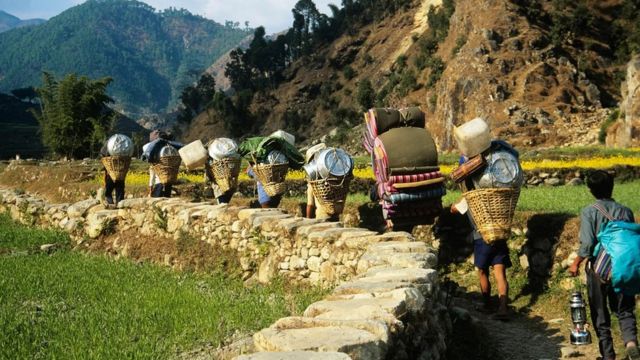
사진 출처,IMAGE SOURCE/GETTY IMAGES
사진 설명,
셰르파들은 티베트에서 벌어진 갈등을 피해 도망친 후 15세기에 쿰부 베율로 왔다
티베트에서 혼란이 벌어지자, 당시 라마였던 상야 도르제는 쿰부 베율을 "개방"할 때라는 판단을 내렸다. 그는 셰르파들을 낭파라를 지나, 물이 풍부해 평화롭게 농작물을 재배하고 야크를 기를 수 있는 땅으로 이끌었다. 도착한 땅은 쿰부(네팔 쪽 에베레스트를 일컫는 이름)였다.
오늘날 쿰부는 해마다 수천 명이 에베레스트 베이스 캠프로 가기 위해 들른다. 하지만 내가 그곳에 갔을 때 만난 이들 중에 자신이 베율에 있다는 것을 알고 있는 이들은 거의 없었다.
그러나 쿰부의 일부 지역에는 베율의 정신이 강하게 남아 있다. 숲이 우거진 경사면에 자리 잡은 라우도 곰파로, 에베레스트 베이스 캠프 서쪽의 보태코시 협곡에서 가장 신성한 곳이다.
곰파(티베트의 작은 수도원)에서 50년 이상 살았다는 82세 여성 승려 다와 산계는 "대부분의 사람들은 쿰부에 네 개의 협곡이 있다고 생각하지만 사실은 다르다"고 했다.

사진 출처,STUART BUTLER
사진 설명,
타메 수도원은 쿰부에서 가장 오래된 수도원이자 영적으로 중요한 의미를 갖는 곳이다
"곰파 뒤에는 드라그카르마라고 불리는 큰 절벽이 있고, 절벽에는 비밀스러운 다섯 번째 계곡으로 이어지는 관문이 있어요. 그게 베율의 심장이죠."
일본, 관광객 입국 재개? 단체 관광객만 가능
코로나19 항공규제 풀린다...비행기표 저렴해질까?
나도 절벽을 볼 수 있겠느냐고 묻자, 그녀는 미소와 함께 고개를 저었다. "대신 다른 것을 보여주겠다"며, 나를 기도실 뒤로 데려갔다. 그리고 작은 문을 열자, 돌출된 바위 밑으로 만들어진 방이 하나 나타났다. 바위를 파서 만든 방의 천장은 여름 하늘의 푸른 색으로 칠해져 있었고, 한 쪽에는 파드마삼바바의 동상이 있었다. 동상 발치에는 방문객들이 놓고 간 과자와 국수, 꽃이 있었다.
다와 산계는 "이곳이 파드마삼바바가 좌선을 하던 곳"이며 "이곳에서 쿰부를 축복하고 그곳을 베율로 바꿨다"고 말했다. 나는 불교 신자는 아니었지만, 벽에 손을 얹자 경외감이 밀려왔다.
승려는 내게 계곡의 더 깊은 곳에 자리한 타메 마을을 권했다. 농지가 끝나고 야크를 키우는 목초지가 시작되는 지점에 있는 타메 수도원은 쿰부에서 가장 오래된 수도원이다. 어떤 이들은 이 곳이 쿰부 베율의 영적인 심장이라고 말할 정도로, 영적으로 중요한 의미를 갖고 있다.
타메까지 이어지는 길은 절벽을 따라 나선형으로 내려갔다가 거대한 산봉우리가 만든 협곡을 따라 올라갔다. 그리고는 땅이 솟구치는 듯한 길 끝에서 타메 마을과 계곡이 활짝 모습을 드러냈다. 이 마을에 있는 타메 수도원 기도실로 들어갔다. 노승 세 명이 노랗게 바랜 양피지에 쓰인 말을 외우고 있었다. 내가 들어가자 그중 한 명이 옆에 있는 의자에 앉으라고 손짓했다.
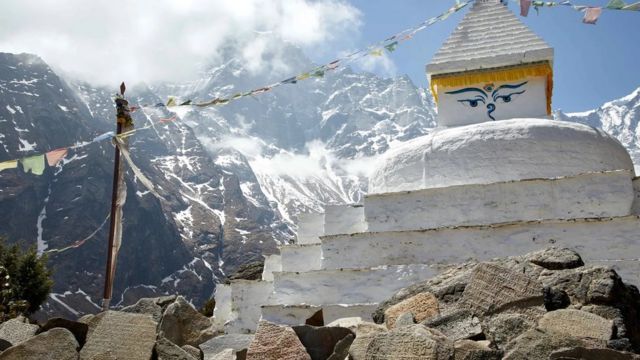
사진 출처,STUART BUTLER
사진 설명,
엄청난 시련과 고난을 극복하고 순수한 마음을 가진 진정한 불교도만이 베율에 들어갈 수 있다
그는 차분한 어조로 "우리가 여기서 기도문을 외울 때, 파드마삼바바가 가끔씩 나타난다"고 말했다. 파드마삼바바의 영혼은 그들의 기도가 세상을 선하게 만든다는 말을 해준다고 했다.
잠시 후 나는 "나는 지금 집에 있다. 나의 낙원 안에 있다"고 말하는 승려를 만났다. 히말라야에 정말로 숨겨진 계곡이 있든 없든, 이들은 평화의 낙원을 찾은 게 분명해 보였다.
떠날 채비를 하는데, 갑자기 출발 전 클라첼이 한 말이 떠올랐다. "베율은 단순한 공간이 아니라, 마음의 상태죠. 평온한 마음의 상태이자 베율을 내면에 만들어내서 고난을 이겨낼 수 있게 해주는 겁니다."

